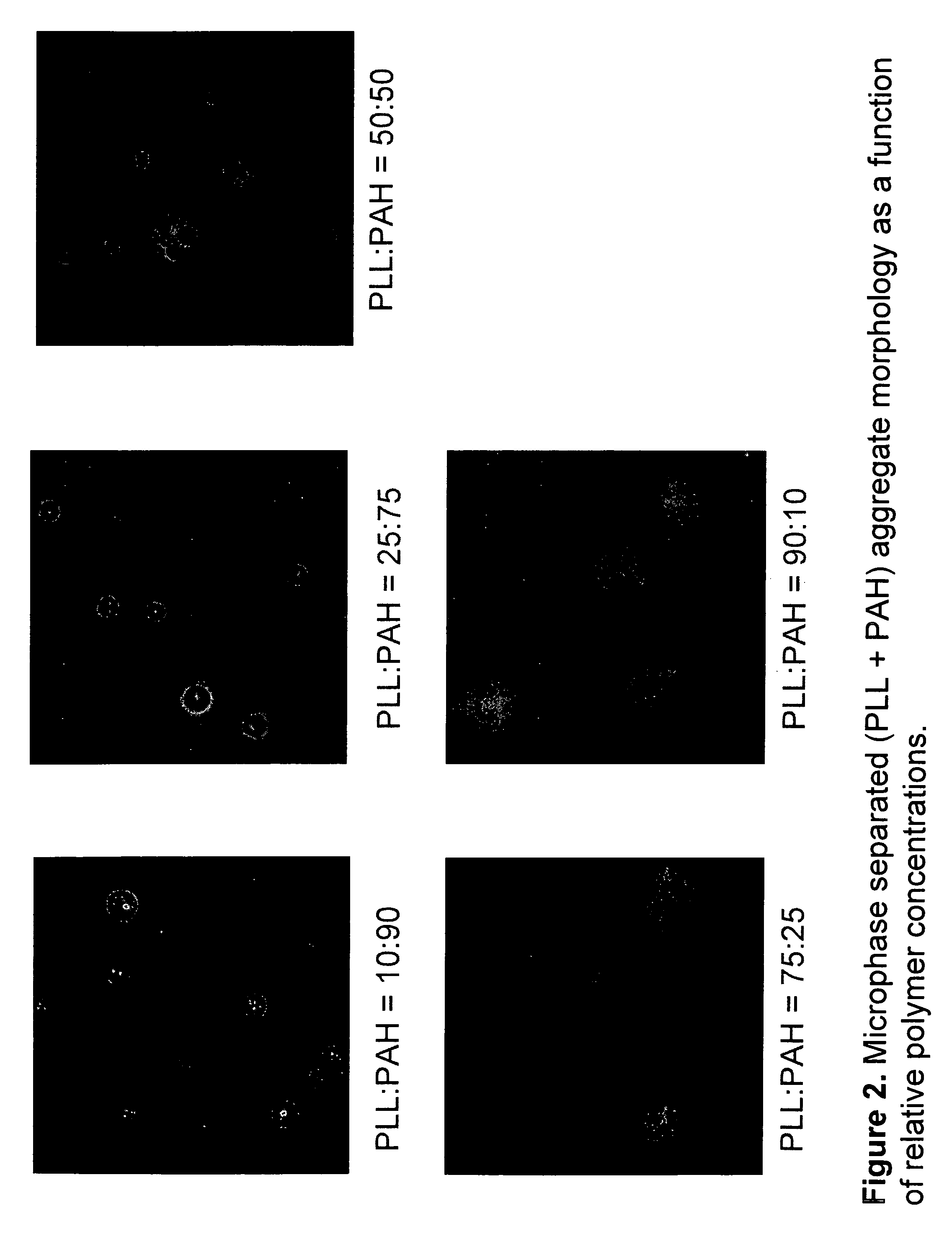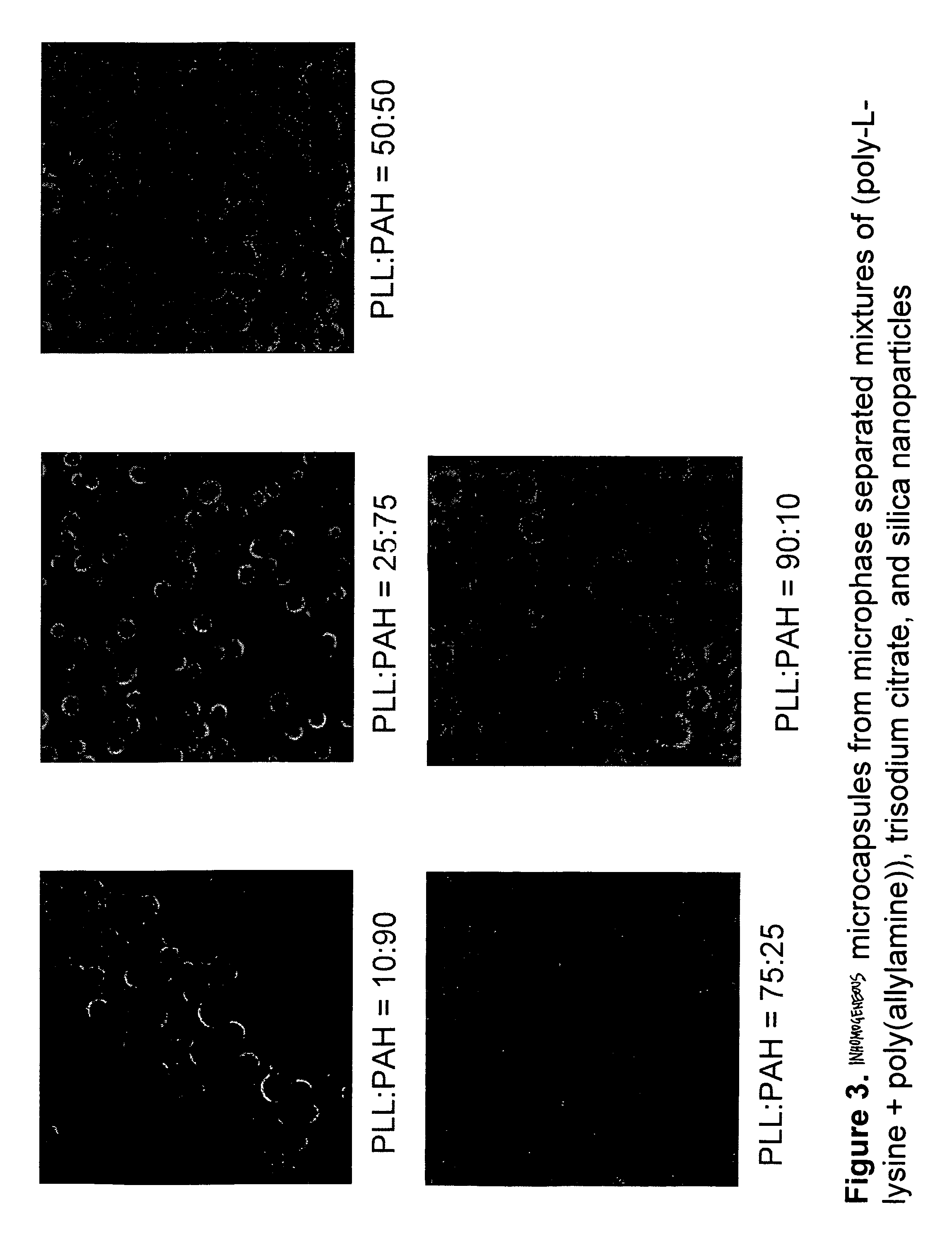Method to fabricate inhomogeneous particles
a technology of inhomogeneous particles and manufacturing methods, which is applied in the field of manufacturing particles, can solve the problems of labor-intensive routes to inhomogeneous particles, difficult task for surface and colloid scientists, etc., and achieve the effect of minimizing uncontrolled aggregation and adsorption and economic and environmental benefits
- Summary
- Abstract
- Description
- Claims
- Application Information
AI Technical Summary
Benefits of technology
Problems solved by technology
Method used
Image
Examples
example i
Microphase Aggregation of Poly-L-lysine and Poly(allylamine) Induced by Multivalent Salts
An aqueous solutions of poly-L-lysine (MW=68.6 kg / mol, HBr salt form, covalently tagged to green fluorescein isothiocyanate dye, PLL) was prepared with a concentration of 4.5 mg / ml. An aqueous solution or poly(allylamine) (MW=70 kg / mol, HCl salt form, covalently tagged to red rhodamine isothiocyanate) was prepared with a concentration of 2 mg / ml. The two solutions were mixed together in a 1.5 ml centrifuge tube in different volume ratios (10:90, 25:75, 50:50, 75:25, 90:10) to give a total volume of 50 μl. To this homogenous mixture, 125 μl of trisodium citrate (28.5 mM) was added and then vortex mixed for 10 sec (solution A). The suspension was aged for 20 min without any mixing. The negative / positive charge ratio R in the solution was kept constant at 10. A drop of the suspension was deposited on a glass slide and sealed under the coverslip for microscopy imaging. The resulting aggregates for v...
example ii
Inhomogeneous Particle Formation with Poly-L-lysine, Poly(allylamine), Trisodium Citrate, and Silica Nanoparticles
An aqueous solutions of poly-L-lysine (MW=68.6 kg / mol, HBr salt form, covalently tagged to green fluorescein isothiocyanate dye, PLL) was prepared with a concentration of 4.5 mg / ml. An aqueous solution or poly(allylamine) (MW=70 kg / mol, HCl salt form, covalently tagged to rhodamine isothiocyanate) was prepared with a concentration of 2 mg / ml. The two solution were mixed together in a 1.5 ml centrifuge tube in different volume ratios (100:0, 90:10, 75:25, 50:50, 25:75, 10:90, 0:100) to give a total volume of 50 μl. To this homogenous mixture, 125 μl of trisodium citrate (28.5 mM) was added and then vortex mixed for 10 sec (solution A). The suspension was aged for 20 min. The positive / negative charge ratio R in the solution was kept constant at 10. To form the inhomogeneous particles, 125 μl of a sol containing silica nanoparticles (Snowtex O, Nissan Chemicals, 20.4 wt. % ...
example iii
Inhomogeneous Particle Formation with Poly-L-lysine, Poly(allylamine), Trisodium Citrate, and Glutaraldehyde
An aqueous solutions of poly-L-lysine (MW=68.6 kg / mol, HBr salt form, covalently tagged to green fluorescein isothiocyanate dye, PLL) was prepared with a concentration of 4.5 mg / ml. An aqueous solution or poly(allylamine) (MW=70 kg / mol, HCl salt form, covalently tagged to rhodamine isothiocyanate) was prepared with a concentration of 2 mg / ml. The two solution were mixed together in a 1.5 ml centrifuge tube in different volume ratios (100:0, 90:10, 75:25, 50:50, 25:75, 10:90, 0:100) to give a total volume of 50 μl. To this homogenous mixture, 125 μl of trisodium citrate (28.5 mM) was added and then vortex mixed for 10 sec (solution A). The suspension was aged for 20 min. The positive / negative charge ratio R in the solution was kept constant at 10. To form the inhomogeneous particles, 50 μl of glutaraldehyde solution (25%) was added to the suspension, vortex mixed for 20 sec (so...
PUM
| Property | Measurement | Unit |
|---|---|---|
| diameter | aaaaa | aaaaa |
| sizes | aaaaa | aaaaa |
| diameter | aaaaa | aaaaa |
Abstract
Description
Claims
Application Information
 Login to View More
Login to View More - R&D
- Intellectual Property
- Life Sciences
- Materials
- Tech Scout
- Unparalleled Data Quality
- Higher Quality Content
- 60% Fewer Hallucinations
Browse by: Latest US Patents, China's latest patents, Technical Efficacy Thesaurus, Application Domain, Technology Topic, Popular Technical Reports.
© 2025 PatSnap. All rights reserved.Legal|Privacy policy|Modern Slavery Act Transparency Statement|Sitemap|About US| Contact US: help@patsnap.com



